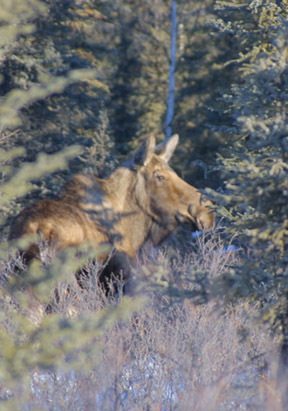
Moose as Ecosystem Engineers
Knut Kielland stopped his snowmachine on the floodplain of the frozen Tanana River. Stepping off into the snow, he issued a challenge:
"Look around you, Mr. Rozell, and show me a willow that has not been hit."
Whips of willow shoots poked through the snow; all were clipped at the same height, as if by a lawnmower. I squinted around looking for a pristine willow. No luck. Moose had snipped them all.
On the Tanana River and all over Alaska, moose are great agents of change. After watching this patch of Alaska for years, Kielland and his colleagues have measured how moose alter succession of the forest, soil chemistry, and even the number and type of insects found where moose live.
Kielland is an associate research professor at the University of Alaska Fairbanks' Institute of Arctic Biology. He and one dozen other scientists study the landscape of the Tanana River floodplain as part of the Long Term Ecological Research program. The Bonanza Creek research site is one of 24 in the United States, Puerto Rico, and Antarctica. The National Science Foundation set up the program in 1980 to study long-term changes in ecological systems. Another site in Alaska is located at Toolik Lake in the Brooks Range.
"Welcome to my backyard," Kielland said as we entered Bonanza Creek research site on snowmachines in early March 2002. He has been working at the LTER site for more than a decade, and has been running his dog team in the wild country just downstream from Fairbanks for longer than that. He and his colleagues have seen impressive changes in the country, many of which have been caused by moose.
Moose alter the landscape with their teeth, especially in winter when their diet consists of woody twigs. Moose will eat balsam poplar, but they prefer willow, aspen and birch. While snowshoe hares and beavers strip bark from twigs like corn on the cob, moose snip twigs and force their digestive systems to separate the carbohydrate-rich bark from the woody cores, converting the latter to pellets. A cow moose weighing 1,000 pounds will eat about 10 pounds of frozen shrubbery each winter day.
To study how all that disappearing wood affects the landscape, Kielland and other ecologists assembled nine moose and hare "exclosures" on the research site in the late 1980s and early 1990s. The exclosures are sections of forest fenced in with 4x4 posts and chicken wire to keep hares and moose from nibbling the vegetation inside. Here, the researchers are able to watch a taiga landscape unaffected by moose.
Inside the exclosures, willows grow tall and their leaves pile up on the forest floor below. Outside the exclosures, alder trees that follow willows after disturbances are colonizing the flood plain at a much faster rate. Moose have reduced the height of the willow forest by as much as 50 percent and the researchers have measured lower relative humidity, higher light intensity, lower soil moisture, and increased soil temperature outside the exclosures. More insects of a greater variety inhabit the moose-impacted area. The researchers also found that moose remove about 50 percent of the new growth stems that pop up from willows each year, speeding up carbon turnover in the forest.
After a decade of research at the Bonanza Creek long-term research site, scientists have concluded that moose are half-ton ecosystem engineers.
"Moose affect everything," Kielland said.





